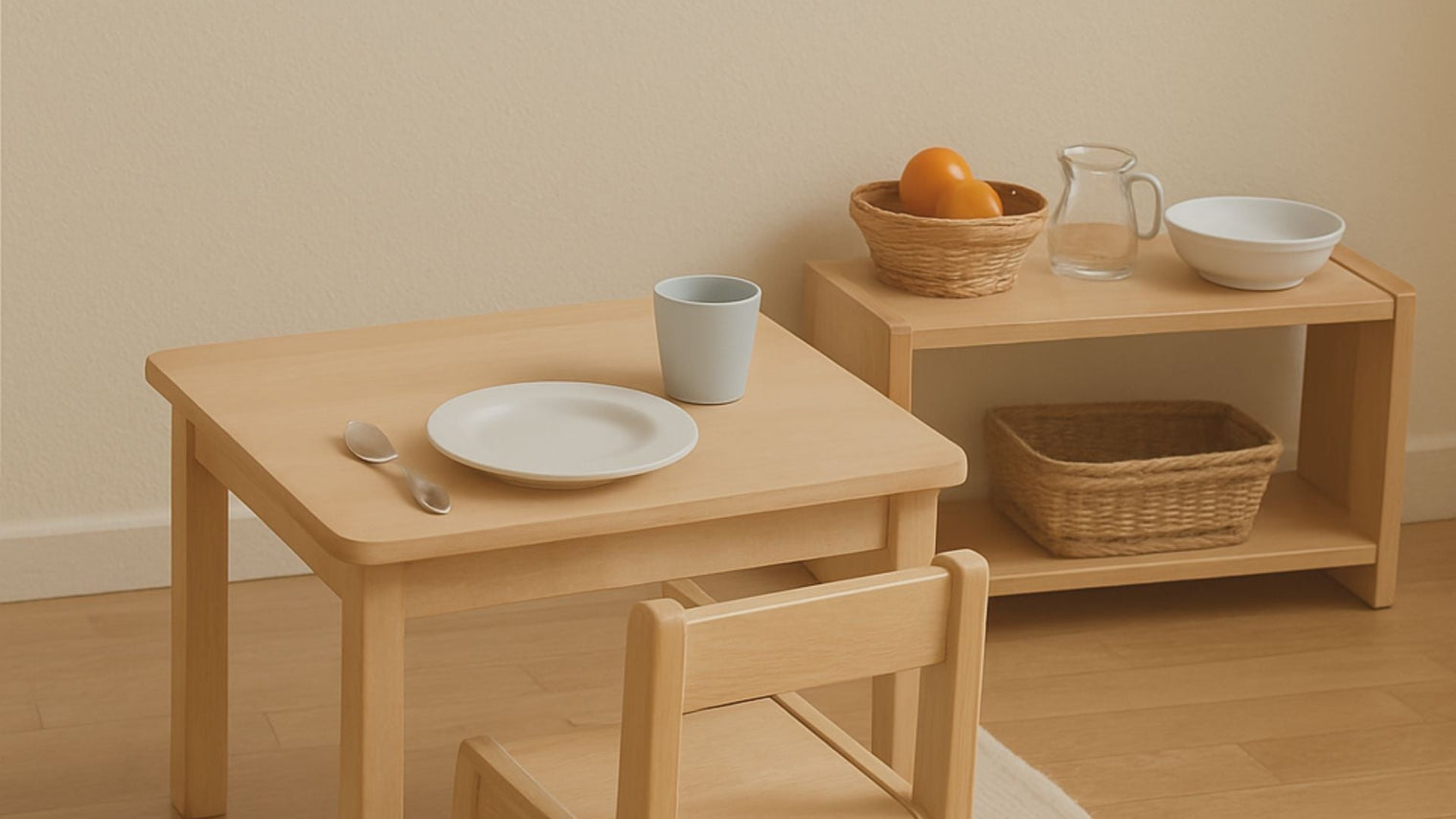As your baby begins to explore solid foods, mealtimes can quickly shift from messy experiments to meaningful learning moments.
One of the most effective ways to support this transition is with a Montessori weaning table—a child-sized table and chair set designed to help little ones eat, explore, and learn independently.
In Montessori philosophy, every piece of a child’s environment plays a role in their development.
A weaning table isn’t just another piece of furniture; it’s a tool for growth, confidence, and independence.
If you’ve ever watched your baby reach for a spoon or insist on feeding themselves, that’s the perfect time to introduce one.
Here’s how to set up a Montessori weaning table for self-feeding—and why this small change can make a big difference in your child’s development.

Unlike a high chair that elevates your child to an adult level, a weaning table brings the dining experience down to their level.
This empowers them to interact with their environment more independently.
The Benefits of a Montessori Weaning Table
- Promotes Independence: It encourages children to feed themselves, enhancing their motor skills.
- Supports Development: Sitting at their own table helps with coordination and concentration.
- Fosters Responsibility: Children learn to clean up after themselves, embedding a sense of responsibility.
Choosing the Right Table and Chair
When selecting your Montessori weaning table and chair set, consider these factors:
Size Matters
Ensure the table and chair are proportional to your child's size. The table should be low enough for your child to sit comfortably with their feet flat on the ground, and the chair should allow them to sit with their knees at a 90-degree angle.
Material Choice
Opt for natural materials like wood, which are durable and safe. These materials offer a tactile experience that aligns with Montessori principles, encouraging children to engage with their surroundings naturally.
Design and Safety
Look for smooth edges and sturdy construction to ensure safety. Also, choose a design that complements your home’s aesthetic while still being child-friendly.
Setting Up Your Montessori Weaning Table

Location, Location, Location
Place the weaning table in a quiet, accessible area of your home where your child can eat undisturbed. Ideally, it should be near the family dining area to foster a sense of inclusion.
Essential Accessories
Equip the table with child-sized utensils and dishes. Choose plates, bowls, and cups that are easy for little hands to handle. Consider using break-resistant materials to prevent accidents.
Encourage Participation
Invite your child to help set up their table. This could include placing utensils or setting the table for meals. This involvement increases their sense of ownership and responsibility.
Incorporating Montessori Principles
Montessori education emphasizes independence, freedom within limits, and respect for a child’s natural development. Here’s how you can incorporate these principles into the weaning process.
Encourage Exploration
Allow your child to explore different foods. Let them touch, smell, and taste a variety of textures and flavors. This sensory exploration is crucial for development.
Respect Their Pace
Let your child eat at their own pace. Avoid rushing them, as this could hinder their enjoyment and learning experience. Patience is key in fostering a positive relationship with food.
Emphasize Cleanliness and Order
Show your child how to clean their table and chair after meals. Use simple, clear instructions and make it a routine. This teaches them the importance of cleanliness and order.
Real-Life Success Stories
Let’s look at some real-life examples of families who have successfully integrated a Montessori weaning table into their home.
The Johnson Family
The Johnsons introduced a Montessori weaning table when their son was 18 months old.
They found that he quickly adapted to self-feeding and enjoyed having his own space. Within weeks, he was eagerly participating in setting up and cleaning his table.
The Patel Family
For the Patel family, the transition to a Montessori weaning table was seamless.
Their daughter thrived in the independent setup and started trying new foods more willingly. The table became a place of exploration and learning.
Common Challenges and Solutions
Introducing a Montessori weaning table can come with challenges. Here are some common issues and how to overcome them:
Mess Management
Self-feeding can be messy, especially at first. Use a mat under the table to catch spills and encourage your child to help with cleaning. Over time, they’ll become more adept at eating neatly.
Resistance to Change
Some children may resist transitioning from a high chair to a weaning table. Introduce the table gradually and make it an exciting, new experience. Sit with them initially to offer comfort and encouragement.
Tips for Success
-
Keep utensils within reach: Teach your child where to find and return their eating tools.
-
Avoid distractions: Turn off screens during meals.
-
Respect their pace: If they’re done eating, let them leave the table. It’s part of learning to listen to their body.
-
Use real materials: Lightweight ceramic or stainless steel gives a more authentic experience than plastic—and children handle them carefully when trusted to do so.
Frequently Asked Questions
When should I introduce a Montessori weaning table?
Most families start around 6–9 months, once their baby can sit up independently and shows interest in self-feeding.
Can I use the weaning table for other activities?
Yes! It’s great for drawing, stacking blocks, or reading short books.
Check out the Montessori Bookshelf to create a complete learning corner.
What materials are best for a weaning table?
Natural wood with a child-safe, non-toxic finish is best. It’s durable, easy to clean, and gives a warm, organic feel to your child’s space.
How do I keep the area clean?
Wipe the table after each meal and encourage your child to help. Use a washable mat under the table for easy cleanup.
Why Choose Dannico Woodworks for Your Montessori Weaning Table
At Dannico Woodworks, we understand that every piece of children’s furniture should be more than just functional—it should inspire confidence and creativity.
As a father-founded brand, every design reflects real parenting experience and child development insight. Each piece is handcrafted with premium, sustainable wood and finished with care to ensure it’s safe, sturdy, and timeless.
From Montessori bookshelves to child-sized tables, every product is designed to encourage independence and make daily routines—like self-feeding—more meaningful and enjoyable.
Explore our full range of handcrafted Montessori furniture at DannicoWoodworks.com.
Final Thoughts
Setting up a Montessori weaning table is more than creating a cute feeding corner—it’s an invitation for your child to grow, learn, and participate in their own care.
Every spoonful, spill, and smile at that table builds confidence and independence that lasts well beyond mealtime.
So, if you’re ready to help your little one take their first steps toward independence, what’s the first thing you’ll add to your Montessori space?

